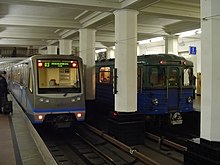User:Kiefobo/Metrovagonmash type E


The E-type metro set is one of the most widespread sets of its kind in the countries of the former Soviet Union. Many other types have been derived from it, including Ečs or 81-71 (Other modifications include the subtypes Em, Ema, Emch, Ev, E1, E1, Em501, Ema502, Emch503, Em508, Em509, E3, Em508T). The E-type cars themselves are then based on older, D-type trains.
The manufacturer began developing these kits in 1956, their unified designation is 81-703. At the end of 1960, the first prototype sets visited the Sokol depot on the second line of the Moscow metro, from where they were then sent on test drives (the first took place on 22 February 1961).
Production took place at the Mytiščín Engineering Plant (now Metrovagonmaš) between 1963 and 1969 (after which it was switched to production of the Ež type), production amounted to about 100–140 cars per year, a total of 824 of them were produced. and the Tbilisi meter; these were all underground railway networks that existed in the USSR at the same time; later Baku joined. They are probably the oldest trains that still carry passengers in some of these networks at the beginning of the 21st century.
The changes compared to the previous type D sets did not only concern the technical part, but also the interior. For example, the doors were widened, two windows were removed from the rear of each car, and closed-type stations were also allowed.
Overview of technical parameters[edit]
| Length | 19 166 mm |
|---|---|
| Width | 2 717 mm |
| Height | 3 695 mm |
| Mass | 31,5 ton |
| Maximal speed | 90 km/h |
| Capacity | 264 passengers |
